Beef Ribs Overview
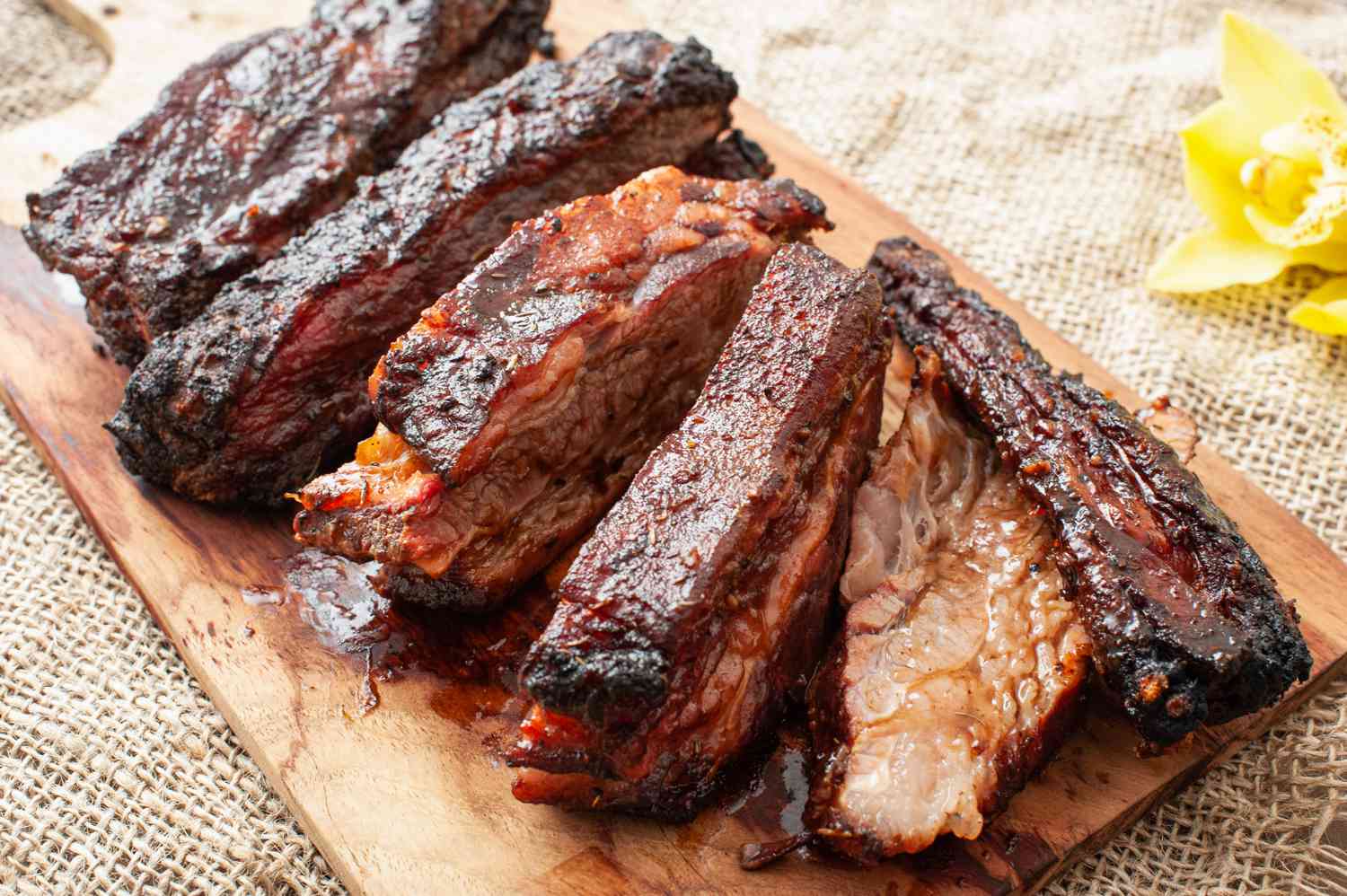
Beef ribs are a popular choice for barbecue enthusiasts and meat lovers alike. These ribs come from the rib section of the cow, resulting in a robust and rich flavor. They are known for their meaty texture and tenderness when cooked properly. Beef ribs are available in different cuts, such as short ribs and back ribs, each offering its own unique taste and texture. While back ribs have less meat due to the removal of the ribeye, they are still delicious and can be enjoyed in various cooking methods, including grilling, smoking, and braising.
Beef Ribs Types And Cuts
There are different types of beef ribs that offer a variety of cuts to choose from. Some popular beef rib cuts include:
- Short Ribs: These are cut from the plate section of the cow and are known for their rich marbling and meaty texture.
- Back Ribs: These ribs come from the rib section of the cow, but have less meat due to the removal of the ribeye. They are still flavorful and can be enjoyed in various cooking methods.
- Chuck Short Ribs: These ribs are cut from the chuck primal and have more fat compared to other cuts. They are great for slow cooking and have a rich flavor.
Beef ribs come in different sizes and weights, allowing for versatility in culinary preparations.
Beef Ribs Flavor Profile
Beef ribs offer a rich and robust flavor profile that is highly cherished by meat lovers. The marbling of fat throughout the meat adds a luscious richness and juiciness to each bite. The slow-cooking process allows the flavors to develop and infuse into the meat, resulting in tender, succulent ribs with a deep, savory taste. The combination of the meat’s natural sweetness and the smoky flavors from grilling or smoking creates a flavorful experience that is hard to resist. Whether seasoned with a simple salt and pepper rub or a bold barbecue sauce, beef ribs deliver a mouthwatering and satisfying flavor.
Pork Ribs Overview
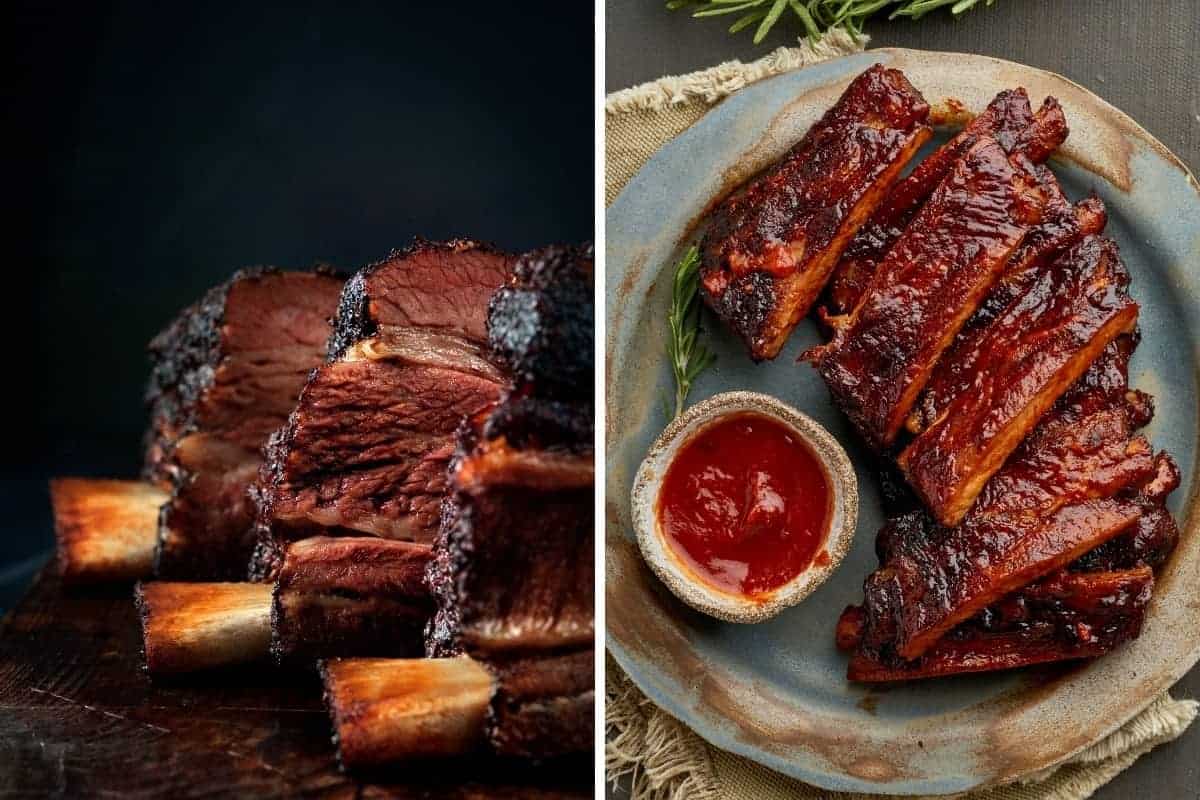
Pork ribs are a popular choice among barbecue enthusiasts and meat lovers. They come in different varieties and cuts, each offering its own unique flavor and texture. Some common types of pork ribs include baby back ribs, spare ribs, and St. Louis-style ribs. Baby back ribs are smaller and leaner, with a tender and juicy meat. Spare ribs are larger and meatier, with a higher fat content that adds richness and flavor to the meat. St. Louis-style ribs are a trimmed and rectangular cut from the spare ribs, offering a balance of meat and fat. When cooked properly, pork ribs are known for their tender and succulent texture, making them a favorite for barbecue and grilling enthusiasts.
Pork Ribs Varieties And Cuts
There are various types of pork ribs, each offering a unique taste and texture. The most popular varieties include baby back ribs, spare ribs, and St. Louis-style ribs. Baby back ribs are smaller and leaner, known for their tender and juicy meat. Spare ribs, on the other hand, are larger and meatier, with a higher fat content that adds richness and flavor. St. Louis-style ribs are a trimmed and rectangular cut from the spare ribs, offering a balanced ratio of meat to fat. Each cut of pork ribs has its own distinct appeal and can be cooked in different ways to enhance their flavors.
Pork Ribs Cooking Methods And Flavors
When it comes to cooking pork ribs, there are various methods that can be used to bring out their delicious flavors. Some popular cooking techniques for pork ribs include grilling, smoking, baking, and slow-cooking. Grilling pork ribs over direct heat is a quick and flavorful method, while smoking them low and slow adds a rich and smoky taste. Baking ribs in the oven with a savory rub can result in tender and juicy meat, and slow-cooking them in a crockpot or pressure cooker allows the flavors to develop over time. The choice of cooking method can greatly influence the taste and texture of pork ribs, offering options to cater to different preferences.
Comparing Beef And Pork Ribs Nutrition
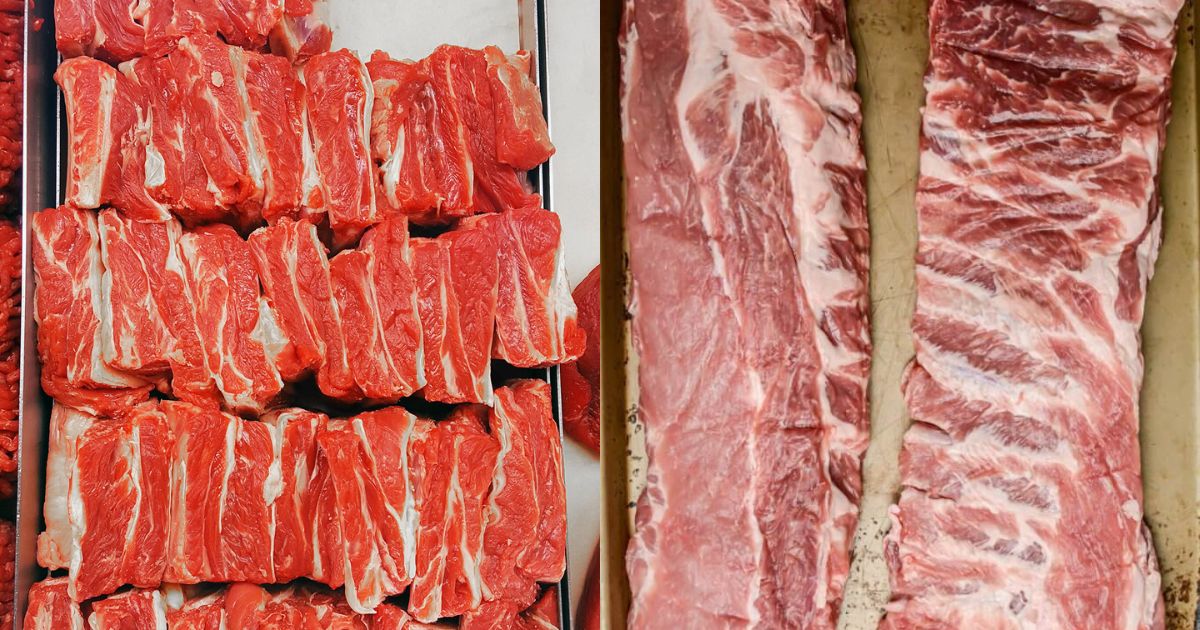
Beef and pork ribs vary in their nutritional content. Beef ribs typically have a higher calorie count, higher amount of protein, and higher amount of iron compared to pork ribs. The difference in fat content between beef and pork ribs also affects the nutritional profile. While both types of ribs can be enjoyed as part of a balanced diet, beef ribs may provide more satiety due to their higher calorie and protein content. It’s important to consider individual dietary needs and preferences when choosing between beef and pork ribs.
Beef Ribs Nutrition Facts
Beef ribs are not only delicious but also contain important nutrients. They are a good source of protein, providing around 19-23 grams per 3-ounce serving. Beef ribs also contain significant amounts of iron, with approximately 2-3 milligrams per serving. However, it’s important to note that beef ribs tend to be higher in calories compared to pork ribs, with around 225-300 calories per serving. They also have a higher fat content, with approximately 16-24 grams of fat per serving. It’s essential to consider portion sizes and balance them with other nutrient-dense foods as part of a healthy diet.
Pork Ribs Nutrition Facts
Pork ribs are not only flavorful but also contain important nutrients. They are a good source of protein, providing around 19-23 grams per 3-ounce serving. Pork ribs also contain essential vitamins and minerals, including iron, zinc, and B vitamins. However, it’s important to note that pork ribs tend to be slightly higher in calories compared to beef ribs, with around 250-350 calories per serving. They also have a moderate amount of fat, with approximately 15-20 grams per serving. As with beef ribs, portion control and balance with other nutritious foods is key when enjoying pork ribs.
Beef Ribs Vs Pork Ribs Taste Test
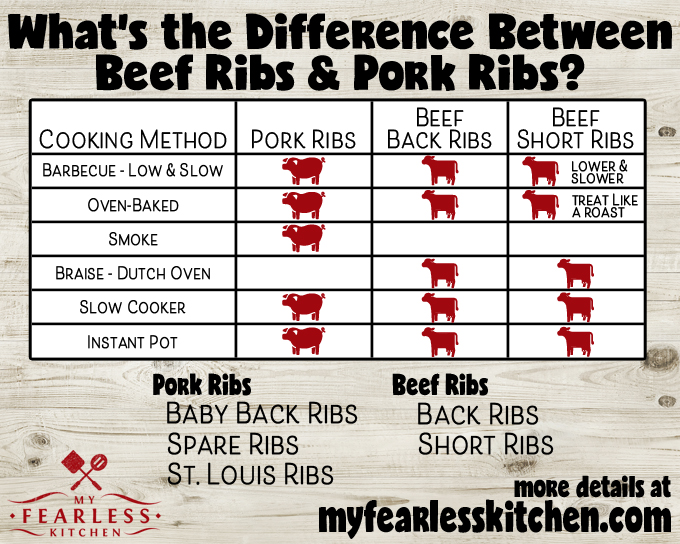
When it comes to taste, beef ribs and pork ribs offer distinct flavors that cater to different preferences. Beef ribs tend to have a rich and intense flavor due to the higher fat content. They offer a bold, meaty taste with a hint of smokiness. On the other hand, pork ribs have a slightly sweeter and milder flavor. They are known for their tenderness and the ability to absorb flavors from marinades and seasonings. Ultimately, the taste test between beef ribs and pork ribs comes down to personal preference and the desired flavor profile for your barbecue or grilling experience.
Beef Ribs Flavor And Texture
Beef ribs offer a unique flavor and texture that sets them apart from other cuts of meat. The flavor of beef ribs is rich, intense, and meaty, thanks to the higher fat content. This richness is further enhanced by the marbling within the meat, which adds extra tenderness and juiciness. The texture of beef ribs is substantial and chewy, with a satisfying bite that ensures a hearty and satisfying eating experience. Whether smoked or grilled, beef ribs provide a robust and bold flavor that meat lovers crave. Their texture and flavor make them an excellent choice for those seeking a savory and indulgent rib experience.
Pork Ribs Taste And Tenderness Comparison
When it comes to taste and tenderness, pork ribs offer a slightly sweeter flavor compared to beef ribs. The natural sweetness of pork pairs well with various seasoning and sauce options, allowing for a versatile and customizable taste experience. In terms of tenderness, pork ribs tend to be more tender and easier to chew compared to beef ribs. This is due to the higher fat content in pork, which adds moisture and tenderness to the meat. Pork ribs are known for their juicy and succulent texture, making them a popular choice among rib enthusiasts.
Cooking Beef And Pork Ribs
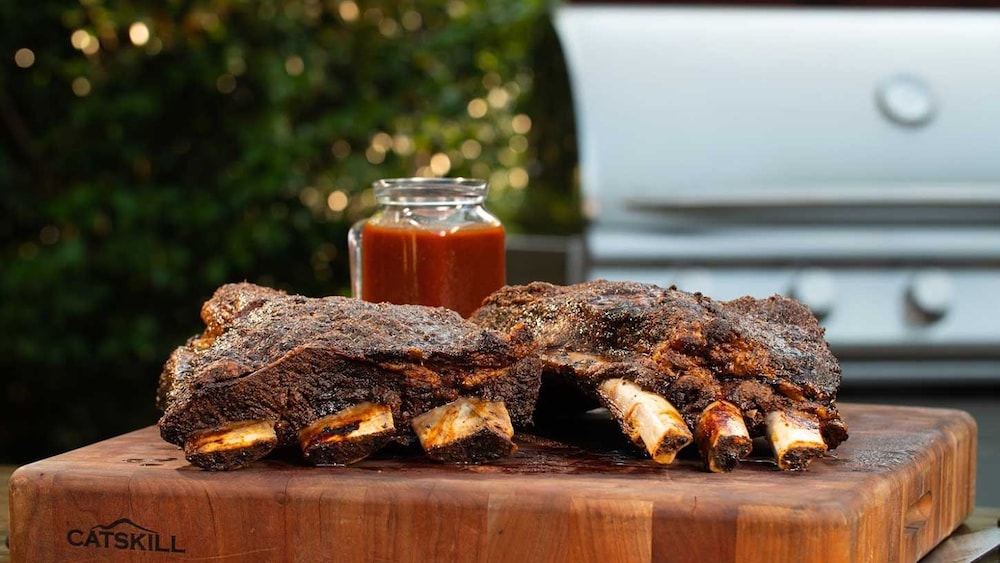
When it comes to cooking beef and pork ribs, there are different preparation and cooking techniques to consider.
For beef ribs, they are often slow-cooked or smoked to achieve tender and flavorful results. This can be done through methods such as low and slow smoking, braising, or using a slow cooker. The goal is to cook the beef ribs until the meat is tender and easily pulls apart from the bone.
On the other hand, pork ribs are also well-suited for slow cooking methods, but they can also be grilled or oven-baked. Grilling pork ribs brings out a delicious smoky flavor and helps caramelize any sauce or seasoning on the meat. Oven-baking is another option, where the ribs are cooked at low heat for several hours until they become tender and juicy.
No matter which cooking method you choose, both beef and pork ribs benefit from marinating or seasoning them before cooking to enhance the flavor profile. Additionally, basting the ribs with a sauce during the cooking process can help keep them moist and add an extra layer of flavor.
Beef Ribs Preparation And Cooking Techniques
Beef ribs require careful preparation and cooking techniques to achieve tender and flavorful results. Here are some popular methods for preparing beef ribs:
- Seasoning: Before cooking, generously season the ribs with a dry rub or marinade to enhance their flavor. Common spices and herbs used include garlic powder, paprika, cumin, and brown sugar.
- Low and Slow Cooking: Beef ribs are best cooked slowly over low heat to break down the tough collagen in the meat. This can be done by smoking the ribs for several hours at a low temperature or by braising them in a flavorful liquid, such as beef broth or barbecue sauce.
- Slow Cooker: Another popular method is using a slow cooker. Place the seasoned ribs in the slow cooker along with your choice of liquid and cook on low heat for several hours until the meat is tender and easily comes off the bone.
- Basting: During the cooking process, baste the ribs with a sauce or marinade to keep them moist and add an extra layer of flavor. This can be done by brushing the ribs with the sauce every 30 minutes or so.
Remember, cooking times may vary depending on the size and thickness of the ribs. It’s important to monitor the ribs closely to ensure they don’t dry out or become overcooked.
Pork Ribs Seasoning And Grilling Tips
When it comes to seasoning and grilling pork ribs, there are a few tips to keep in mind. First, choose a seasoning rub that complements the natural sweetness of the pork. Classic flavors like brown sugar, paprika, garlic powder, and black pepper work well. Allow the ribs to marinate in the rub for at least an hour, or even overnight, for maximum flavor penetration. For grilling, preheat the grill to medium-low heat and cook the ribs slowly, turning occasionally to ensure even cooking. Baste the ribs with your favorite barbecue sauce towards the end of cooking for added flavor and caramelization. Remember to let the ribs rest for a few minutes before serving to allow the juices to redistribute.
Conclusion
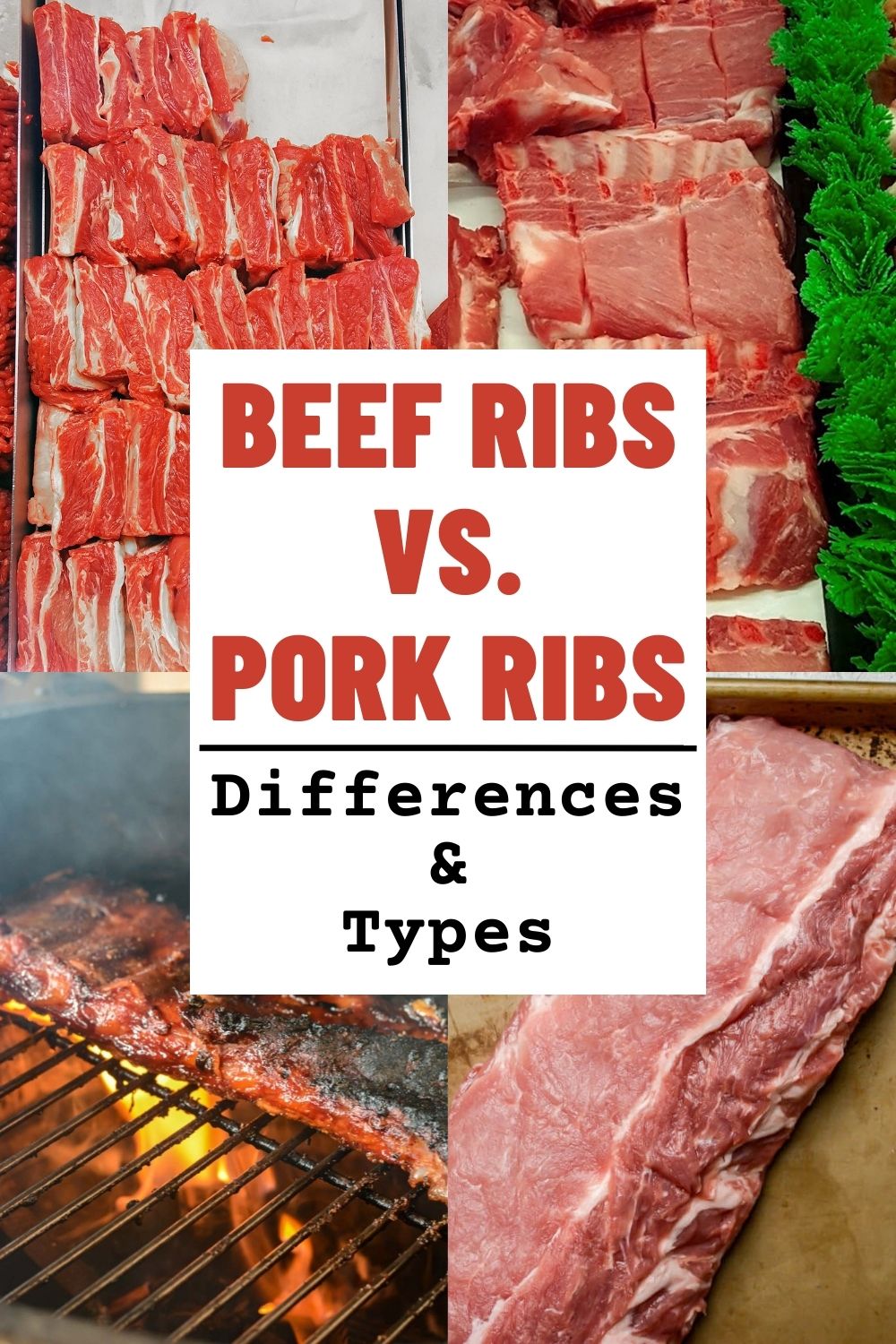
In conclusion, when it comes to beef ribs vs pork ribs, there are significant differences in taste, texture, and cooking methods. Beef ribs are known for their rich flavor and tenderness, while pork ribs are leaner and offer a slightly sweeter taste. The choice between beef and pork ribs ultimately comes down to personal preference and desired flavor profile. Whether you prefer the boldness of beef ribs or the sweetness of pork ribs, both options provide a delicious and satisfying dining experience. So, go ahead and choose your favorite ribs based on your individual taste preferences.
Key Differences Between Beef And Pork Ribs
Beef and pork ribs have several key differences in terms of taste, texture, and cooking methods. Some of the main differences include:
- Flavor: Beef ribs have a rich and intense flavor, whereas pork ribs have a slightly sweeter taste.
- Texture: Beef ribs tend to be more tender and succulent, while pork ribs can be leaner and have a firmer texture.
- Fat content: Beef ribs are generally fattier than pork ribs, which contributes to their rich flavor and tenderness.
- Cooking methods: Beef ribs are often slow-cooked or smoked to enhance their flavor and tenderness, while pork ribs can be grilled, baked, or braised.
- Cut differences: Beef ribs are generally cut from the rib section of the cow, while pork ribs can come from different parts of the pig, such as the back ribs or spare ribs.
Ultimately, the choice between beef and pork ribs comes down to personal preference and desired flavor profile.
Which Type Of Ribs To Choose For Different Preferences
When it comes to choosing between beef and pork ribs, it ultimately depends on individual preferences.
If you enjoy a rich and intense flavor, along with tenderness and succulence, then beef ribs are the way to go. They are perfect for slow-cooking or smoking to enhance their taste and texture.
On the other hand, if you prefer a slightly sweeter taste and a leaner, firmer texture, pork ribs are a great choice. They can be grilled, baked, or braised to bring out their unique flavors.
Ultimately, the decision between beef and pork ribs comes down to personal preference and desired flavor profiles. So, choose the type of ribs that best suits your taste and enjoy a delicious meal.
FAQ About Beef Vs Pork Ribs: Comparing Rib Cuts
Q: What is the main difference between beef ribs and pork ribs?
A: The main difference lies in the source animal – beef ribs come from cattle, while pork ribs come from pigs. This difference in the source animal also affects factors such as flavor, texture, and cooking methods.
Q: Which type of rib is typically more tender – beef or pork?
A: Pork ribs are typically more tender than beef ribs. Pork ribs have a higher fat content compared to beef ribs, which contributes to their tenderness and juiciness when cooked properly.
Q: Are there any significant flavor differences between beef and pork ribs?
A: Yes, there are distinct flavor differences between beef and pork ribs. Beef ribs have a rich, meaty flavor with a slightly sweet undertone, while pork ribs offer a more savory and slightly sweeter taste profile.
Q: What are the different cuts of beef and pork ribs available?
A: The main cuts of beef ribs include short ribs, back ribs, and beef plate ribs. For pork ribs, common cuts include baby back ribs (loin ribs) and spare ribs (side ribs). Each cut has its own unique characteristics and cooking requirements.
Q: How do cooking methods vary between beef and pork ribs?
A: Beef ribs are often cooked low and slow to break down the tough connective tissue and render the fat for a tender result. Pork ribs can also benefit from low and slow cooking but can be cooked faster due to their inherent tenderness.
Q: Can the choice between beef and pork ribs depend on personal preferences?
A: Absolutely. The choice between beef and pork ribs often comes down to personal preferences in terms of flavor, tenderness, fat content, and cooking methods. Experimenting with both types of ribs can help determine individual preferences.

We are introducing OH! NANA, where culinary excellence meets sustainability! Our journey began with a passion for creating delicious, nutrient-dense dishes while minimizing waste and environmental impact. At OH! NANA, we believe that great taste and nutritional value can go hand in hand with responsible sourcing and production. Our commitment to delivering intense flavors and high nutritional value is paired with a dedication to reducing waste in every aspect of our operations. From sourcing fresh, locally-grown ingredients to implementing efficient kitchen practices, we strive to positively impact both your health and the health of our planet.